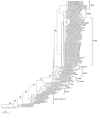Rapid Emergence of Highly Pathogenic Avian Influenza Subtypes from a Subtype H5N1 Hemagglutinin Variant
- PMID: 25897518
- PMCID: PMC4412238
- DOI: 10.3201/eid2105.141927
Rapid Emergence of Highly Pathogenic Avian Influenza Subtypes from a Subtype H5N1 Hemagglutinin Variant
Abstract
In 2014, novel highly pathogenic avian influenza A H5N2, H5N5, H5N6, and H5N8 viruses caused outbreaks in Asia, Europe, and North America. The H5 genes of these viruses form a monophyletic group that evolved from a clade 2.3.4 H5N1 variant. This rapid emergence of new H5Nx combinations is unprecedented in the H5N1 evolutionary history.
Keywords: H5N1; HPAI; avian influenza; clade 2.3.4; evolution; hemagglutinin; highly pathogenic; influenza; monophyletic group; rapid emergence; reassortant; reassortment events; subtype; variant; virulent; viruses.
Figures


References
-
- World Health Organization. Cumulative number of confirmed human cases for avian influenza A(H5N1) reported to WHO, 2003–2015 [cited 2015 Jan 19]. http://www.who.int/influenza/human_animal_interface/EN_GIP_20150106Cumul...
MeSH terms
Substances
LinkOut - more resources
Full Text Sources
Other Literature Sources
Medical

